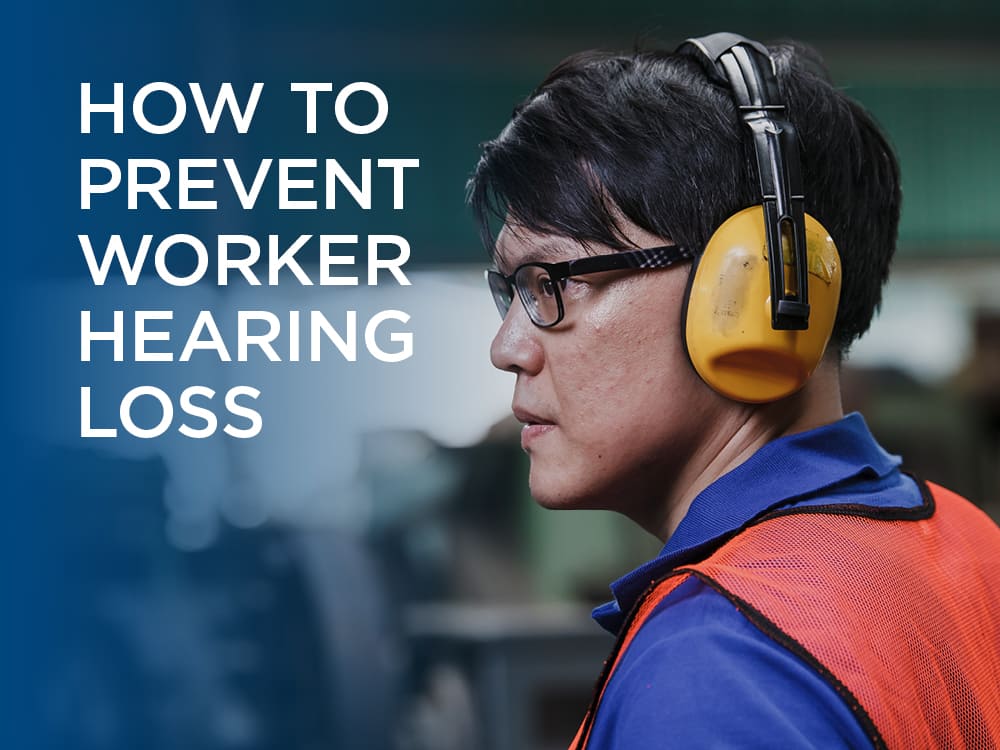- Home
- Loss Control
- Loss Control Insights
- How to Prevent Worker Hearing Loss
The Center for Disease Control (CDC) estimates that 22 million workers are exposed to potentially damaging noise at work each year. Not surprisingly, hearing loss is among the most common work-related illnesses, affecting a variety of industries and job categories.
Work-related hearing loss is caused by loud noise and ototoxic chemicals causing damage to the inner ear. While hearing loss is not reversible, it is preventable.
Why Is Preventing Hearing Loss Important?
Short-term exposure to high levels of noise can cause a temporary change in hearing (your ears may feel stuffed up) or you may experience a ringing in your ears (tinnitus). There is no way for ears to “get used to” noise and repeated exposure can lead to permanent health effects that impact quality of life. Loud noise can create physical and psychological stress, cause anxiety and depression, interfere with concentration and even lead to heart disease.
Additionally, hearing loss can affect your workplace through reduced productivity. It is also a safety hazard that can contribute to accidents and injuries by interfering with communication and making it difficult to hear warning signals.
Know Your Workplace Noise Levels!
The first step to prevention is understanding your workplace noise levels. Noise intensity and duration of exposure are critical factors in evaluating the potential for employee hearing loss. OSHA requires employers to implement a hearing conservation program (more on this below) when noise exposure is at or above 85 decibels averaged over 8 working hours, or an 8-hour time-weighted average. Noise may be a problem in your workplace if you:
- Hear ringing or humming in your ears when you leave work
- Need to raise your voice to speak to someone 3 feet away
- Experience temporary hearing loss when leaving work
Several sound-measuring instruments are available to measure the noise levels in a workspace. These include sound level meters, noise dosimeters and octave band analyzers. The National Institute for Occupational Safety and Health (NIOSH) Sound Level Meter App measures sound levels in the workplace and provides noise exposure parameters to help reduce occupational noise-induced hearing loss.
Chart: Typical Sounds Levels
Implement a Hearing Conservation Program
Hearing conservation programs are designed to prevent noise-induced hearing loss, preserve and protect remaining hearing and equip workers with the knowledge and hearing protection devices necessary to safeguard their hearing. Below, we outline seven key steps your company should take to prevent worker hearing loss.
Reduce Equipment Noise
—Keeping your equipment in tip-top shape can help reduce noise levels. Replace worn parts and apply lubrication when needed. Additionally, you should consider replacing equipment with quieter substitutes—use NIOSH’s Buy Quiet Power Tool Database to help you find the right tools.Reduce Noise Exposure
—If noise cannot be reduced, you can help protect your workers by reducing their exposure through sound barriers or by scheduling noisy activities during times/days when fewer people are working.Take a Break
—Limit the time workers are exposed to noise by implementing a break schedule or rotating duties.Increase Distance
—Keep workers as far away from the source of noise as possible.Keep Employees in the Loop
—Workers must understand the noise hazards present in the workplace. Provide training, discuss hazardous noise at safety meetings and place warning signs throughout areas where noise can be expected.Stop Chemical Exposure
—Reduce or stop worker exposure to chemicals that may damage hearing by using a less toxic or nontoxic chemical. Additionally, workers should be trained to follow all chemical safety instructions and wear appropriate personal protective equipment (PPE) when handling chemicals.Provide the Right PPE
—Protective equipment, such as ear plugs or earmuffs, should be used as a last resort because you should always investigate engineering and administrative controls first. If PPE is your only option, make sure workers are trained on the proper fit and usage. Depending on the level of noise, your workers may need to wear more than one type of protection.
EMC Hearing Conservation Program Assistance
Using state-of-the-art testing equipment, your EMC loss control representative can assess noise levels in your work environment and assist in the development and implementation of a comprehensive program that addresses engineering controls, monitoring and testing procedures, hearing protection devices, training and recordkeeping.
Occupational Hearing Loss Resources
- EMC Insights: Four Hearing Loss Prevention Steps
- EMC Insights: Turn Down the Volume at Your Jobsite
- EMC Safety Brief: FAQ on Hearing Loss
- NIOSH Science Blog: Protecting Worker Hearing
- NIOSH: How To Wear Soft Foam Earplugs
- NIOSH: Noise Meter
- NIOSH: Preventing Occupational Hearing Loss - A Practical Guide
- OSHA: Occupational Noise Exposure
- OSHA: Preventing Hearing Loss Caused by Chemical (Ototoxicity) and Noise Exposure
Get in touch
Need help? We’re here for you! Whether you have questions or need personalized assistance, your local office is ready to support you.
Loss Control Insights
Stay informed with the latest news and receive actionable safety tips, all carefully curated by our team of experts.
